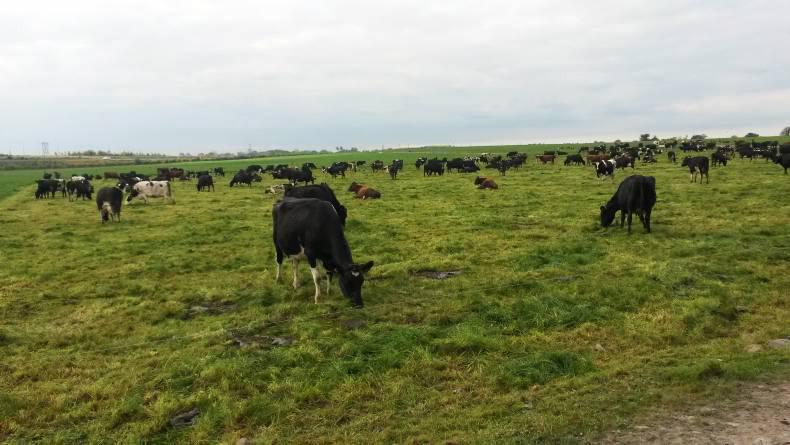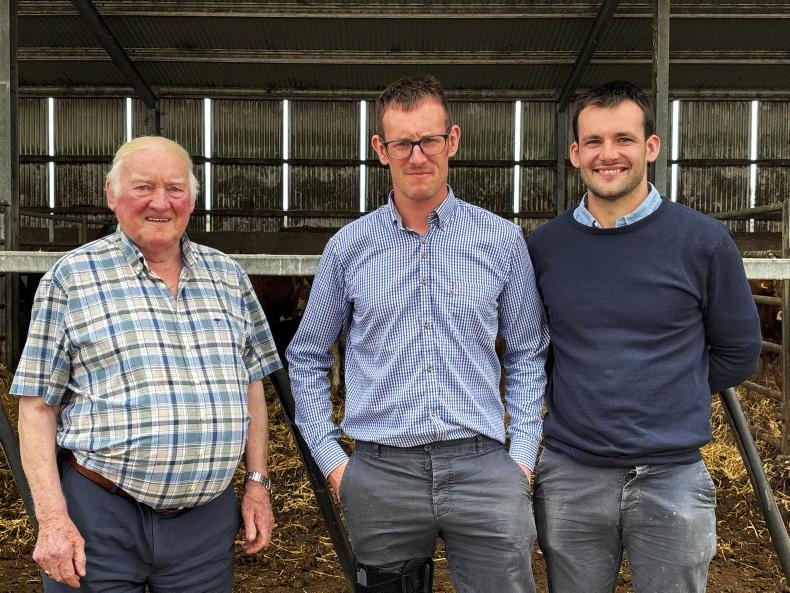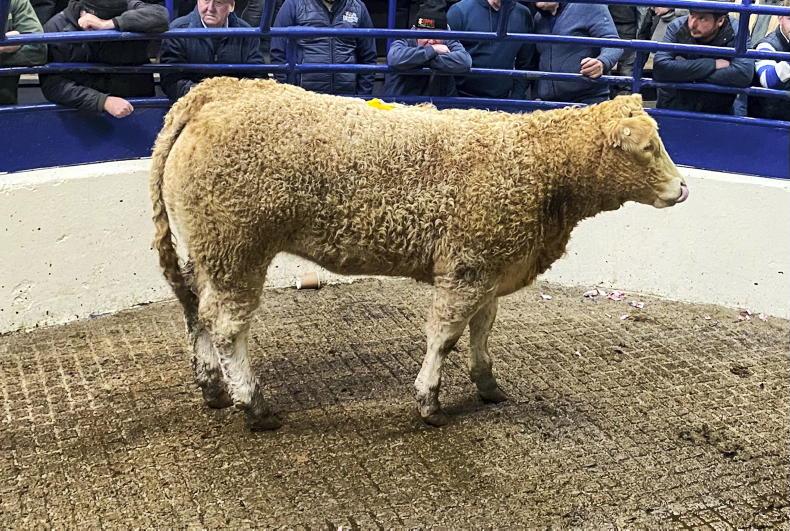The Kepak Group has nine food manufacturing and slaughtering facilities across the UK and Ireland. Each year, 3,500 to 4,000 cattle are finished on its feedlot in Clonee, with around 1,800 cattle on site at any one time.
Approximately 60% of cattle are bought on farm, usually from the same list of farmers, with a price per kilo agreed with the supplier and based on the weight of the animal when it arrives on the feedlot. The remaining cattle are procured by three agents at marts around the country.
Feedlot manager Greg McCloskey said that the feedlot is used primarily to fill gaps in the Kepak slaughter mix with the focus mainly on continental-bred cattle and Herefords. No dairy-bred bulls are finished as these are readily available elsewhere on farms. The feedlot operates as a standalone business entity within the Kepak Group and receives the same prices as other beef finishers and the same penalties if carcases are not in spec.
Stress
On arrival at the feedlot, all cattle are rested for 24 to 36 hours in a straw-bedded pen and given hay and water. Cattle are then clipped, weighed, footbathed, given a management tag, injected for worms and fluke and vaccinated for pneumonia and clostridia diseases.
Greg said that resting cattle lowered stress levels and made vaccinations more effective. There is a similar onus on limiting stress when cattle are ready for slaughter, particularly young bulls, which are more likely to end up as dark cutting meat. The aim is to have them killed at the factory within one hour of removing them from pens.
The bulls are mostly Charolais and Limousin, bought at around 400kg liveweight and generally finished for the Italian market at under 20 months with the carcase an E or U grade and under 400kg.
The feedlot also produces continental steers for the UK market, while some bulls destined for this market are finished at under 16 months.
The other main finishing group on the feedlot are Hereford cattle, sourced from the dairy herd and destined for the Musgrave group for the Signature Taste range in Supervalu stores. A bonus of 15c/kg is paid for Hereford cattle up to 330kg carcase weight, reduced to 10c/kg up to 380kg.
The Hereford heifers are kept on straw-bedding. For a group of 48 heifers, this requires approximately three 8 x 4 x 3 bales once a week. All other cattle are on slats and grouped according to their weight and expected slaughter date.
Crops
Around the feedlot, 320ha of farmland is used to grow wheat, barley and maize for feeding to cattle. Grass is also grown, mostly for silage, but some younger heifers are put to grass in the summer.
Cattle are built up to the finishing ration gradually over 20 days with starter diets containing 25% of the concentrate levels of the finishing ration to prevent stomach ulcers, acidosis and laminitis. The target is to have dry matter intakes of 2.2% of body weight. “Heifers and bulls get the same base diet. Bulls are usually on 12.5% to 12.8% crude protein, but for heifers we found that we had to push this over 13% as they were becoming too fat in the finishing stage. All water troughs are checked every day as water is important in these high concentrate diets,” Greg said.
Two feeder wagons operate and feeding out is usually finished by lunchtime each day. Staff aim to have as little feed left over as possible with each pen’s ration adjusted daily in line with the previous day’s intakes.
Genetics
Looking to the future, Greg believes that the genetic ability of an animal will increasingly dictate procurement decisions.
He maintained that the system of star rating developed by the Irish Cattle Breeding Federation (ICBF) helps to identify animals that will have superior weight gain.
Analysis of data from the feedlot has shown that young bulls from sires with five-star ratings for terminal traits have daily weight gains of 2.2kg to 2.3kg.
They consistently outperform animals from one-star bulls, which have weight gains of only 1.1kg to 1.2kg, despite being fed and managed under the same conditions.
Brothers Tony and Patrick and their nephew John McGuinness farm 3,000 acres in partnership together in Richardstown, near Ardee Co Louth. All land is under tillage with the largest proportion in a high-input, high-output winter cereal system.
Speaking to members of the NIIAS during their study tour last week, Tony said that each partner owns an equal amount of the farm but the family decides to pool everything together to manage it as one business. In total, 1,000 acres of land are owned, with the rest rented, a significant proportion of which is on long-term leases allowing for investment in the land for the benefit of both parties.
Grain is marketed by forward selling to avoid volatility in prices. Most is sold to a local merchant and some to pig farmers in NI. Winter oats are forward sold for export to Spain from the docks in Drogheda.
Winter barley straw goes to NI and winter wheat straw goes to mushroom composters with the compost subsequently returning for spreading. Some wheat straw was also chopped this year as well as all oat and oilseed rape straw.
Potatoes are grown on contract for K & K Produce and leave the farm as soon as they are harvested. In total, 200 acres, mainly of the Rooster variety, are grown.
Machinery
“There are five full-time and five part-time staff on the farm, plus family labour. We change all tractors and the two combines every three years, so we know after our repayments all parts and labour costs are taken care of by the dealership,” Tony said.
He said that, typically, a tractor will have 4,000 to 4,500 hours after the three years, but all other machinery is kept and maintained for as long as possible. For example one, of the two potato harvesters was bought in the 1970s.
Minimum tillage is used when sowing all oilseed rape, which totals about 200 acres. Also, for about 300 acres of the winter wheat and for a proportion of the 500 acres of oats, the seedbed is prepared by a light discing, and then a pass with the minimum tillage sower.
Tony said: “Min-till is good for labour-saving at the time of sowing but you need to do it early. With an ordinary plough, till and sow system, you are almost certain to have a crop and will spend less time controlling grass and weeds.”
All fertiliser, diesel and sprays are purchased through a discussion group. The group farms over 5,000 acres in total and it can mean significant savings for members when dealing with suppliers.
The McGuinness partnership alone buys 1,000t of fertiliser per year.
Some of the less productive land on the farm is now used to grow willow, and this has the potential to increase in future years, particularly if a renewable heat incentive scheme is introduced in the Republic of Ireland. A €500,000 willow store containing two storage floors and two drying floors was constructed in 2014 with the help of a €200,000 Government grant.
Currently, five tonnes of dried willow are supplied to a district heating partnership in Dundalk every week, as well as some other smaller customers. The willow is sold at a price similar to dried grain (approximately €150/t).
1,000 acres of wheat.1,000 acres of barley.500 acres of oats.200 acres of potatoes.200 acres of oilseed rape.80 acres of willow.
The Kepak Group has nine food manufacturing and slaughtering facilities across the UK and Ireland. Each year, 3,500 to 4,000 cattle are finished on its feedlot in Clonee, with around 1,800 cattle on site at any one time.
Approximately 60% of cattle are bought on farm, usually from the same list of farmers, with a price per kilo agreed with the supplier and based on the weight of the animal when it arrives on the feedlot. The remaining cattle are procured by three agents at marts around the country.
Feedlot manager Greg McCloskey said that the feedlot is used primarily to fill gaps in the Kepak slaughter mix with the focus mainly on continental-bred cattle and Herefords. No dairy-bred bulls are finished as these are readily available elsewhere on farms. The feedlot operates as a standalone business entity within the Kepak Group and receives the same prices as other beef finishers and the same penalties if carcases are not in spec.
Stress
On arrival at the feedlot, all cattle are rested for 24 to 36 hours in a straw-bedded pen and given hay and water. Cattle are then clipped, weighed, footbathed, given a management tag, injected for worms and fluke and vaccinated for pneumonia and clostridia diseases.
Greg said that resting cattle lowered stress levels and made vaccinations more effective. There is a similar onus on limiting stress when cattle are ready for slaughter, particularly young bulls, which are more likely to end up as dark cutting meat. The aim is to have them killed at the factory within one hour of removing them from pens.
The bulls are mostly Charolais and Limousin, bought at around 400kg liveweight and generally finished for the Italian market at under 20 months with the carcase an E or U grade and under 400kg.
The feedlot also produces continental steers for the UK market, while some bulls destined for this market are finished at under 16 months.
The other main finishing group on the feedlot are Hereford cattle, sourced from the dairy herd and destined for the Musgrave group for the Signature Taste range in Supervalu stores. A bonus of 15c/kg is paid for Hereford cattle up to 330kg carcase weight, reduced to 10c/kg up to 380kg.
The Hereford heifers are kept on straw-bedding. For a group of 48 heifers, this requires approximately three 8 x 4 x 3 bales once a week. All other cattle are on slats and grouped according to their weight and expected slaughter date.
Crops
Around the feedlot, 320ha of farmland is used to grow wheat, barley and maize for feeding to cattle. Grass is also grown, mostly for silage, but some younger heifers are put to grass in the summer.
Cattle are built up to the finishing ration gradually over 20 days with starter diets containing 25% of the concentrate levels of the finishing ration to prevent stomach ulcers, acidosis and laminitis. The target is to have dry matter intakes of 2.2% of body weight. “Heifers and bulls get the same base diet. Bulls are usually on 12.5% to 12.8% crude protein, but for heifers we found that we had to push this over 13% as they were becoming too fat in the finishing stage. All water troughs are checked every day as water is important in these high concentrate diets,” Greg said.
Two feeder wagons operate and feeding out is usually finished by lunchtime each day. Staff aim to have as little feed left over as possible with each pen’s ration adjusted daily in line with the previous day’s intakes.
Genetics
Looking to the future, Greg believes that the genetic ability of an animal will increasingly dictate procurement decisions.
He maintained that the system of star rating developed by the Irish Cattle Breeding Federation (ICBF) helps to identify animals that will have superior weight gain.
Analysis of data from the feedlot has shown that young bulls from sires with five-star ratings for terminal traits have daily weight gains of 2.2kg to 2.3kg.
They consistently outperform animals from one-star bulls, which have weight gains of only 1.1kg to 1.2kg, despite being fed and managed under the same conditions.
Brothers Tony and Patrick and their nephew John McGuinness farm 3,000 acres in partnership together in Richardstown, near Ardee Co Louth. All land is under tillage with the largest proportion in a high-input, high-output winter cereal system.
Speaking to members of the NIIAS during their study tour last week, Tony said that each partner owns an equal amount of the farm but the family decides to pool everything together to manage it as one business. In total, 1,000 acres of land are owned, with the rest rented, a significant proportion of which is on long-term leases allowing for investment in the land for the benefit of both parties.
Grain is marketed by forward selling to avoid volatility in prices. Most is sold to a local merchant and some to pig farmers in NI. Winter oats are forward sold for export to Spain from the docks in Drogheda.
Winter barley straw goes to NI and winter wheat straw goes to mushroom composters with the compost subsequently returning for spreading. Some wheat straw was also chopped this year as well as all oat and oilseed rape straw.
Potatoes are grown on contract for K & K Produce and leave the farm as soon as they are harvested. In total, 200 acres, mainly of the Rooster variety, are grown.
Machinery
“There are five full-time and five part-time staff on the farm, plus family labour. We change all tractors and the two combines every three years, so we know after our repayments all parts and labour costs are taken care of by the dealership,” Tony said.
He said that, typically, a tractor will have 4,000 to 4,500 hours after the three years, but all other machinery is kept and maintained for as long as possible. For example one, of the two potato harvesters was bought in the 1970s.
Minimum tillage is used when sowing all oilseed rape, which totals about 200 acres. Also, for about 300 acres of the winter wheat and for a proportion of the 500 acres of oats, the seedbed is prepared by a light discing, and then a pass with the minimum tillage sower.
Tony said: “Min-till is good for labour-saving at the time of sowing but you need to do it early. With an ordinary plough, till and sow system, you are almost certain to have a crop and will spend less time controlling grass and weeds.”
All fertiliser, diesel and sprays are purchased through a discussion group. The group farms over 5,000 acres in total and it can mean significant savings for members when dealing with suppliers.
The McGuinness partnership alone buys 1,000t of fertiliser per year.
Some of the less productive land on the farm is now used to grow willow, and this has the potential to increase in future years, particularly if a renewable heat incentive scheme is introduced in the Republic of Ireland. A €500,000 willow store containing two storage floors and two drying floors was constructed in 2014 with the help of a €200,000 Government grant.
Currently, five tonnes of dried willow are supplied to a district heating partnership in Dundalk every week, as well as some other smaller customers. The willow is sold at a price similar to dried grain (approximately €150/t).
1,000 acres of wheat.1,000 acres of barley.500 acres of oats.200 acres of potatoes.200 acres of oilseed rape.80 acres of willow. 















SHARING OPTIONS